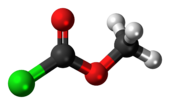Chemistry:Methyl chloroformate

| |

| |
| Names | |
|---|---|
| Preferred IUPAC name
Methyl carbonochloridate | |
| Other names
Methyl chloroformate, Chlorocarbonic methyl ester, Methyl chlorocarbonate
| |
| Identifiers | |
3D model (JSmol)
|
|
| 605437 | |
| ChemSpider | |
| EC Number |
|
PubChem CID
|
|
| UNII | |
| |
| |
| Properties | |
| ClC(O)OCH 3 | |
| Molar mass | 94.49 g·mol−1 |
| Appearance | Colorless oily liquid |
| Odor | Pungent |
| Density | 1.223 g/mL |
| Boiling point | 70 to 72 °C (158 to 162 °F; 343 to 345 K) |
| Hazards | |
| GHS pictograms |   
|
| GHS Signal word | Danger |
| H225, H302, H312, H314, H330 | |
| P210, P233, P240, P241, P242, P243, P260, P264, P270, P271, P280, P284, P301+312, P301+330+331, P302+352, P303+361+353, P304+340, P305+351+338, P310, P312, P320, P321, P322, P330, P363 | |
| Flash point | 10 °C (50 °F; 283 K) |
Except where otherwise noted, data are given for materials in their standard state (at 25 °C [77 °F], 100 kPa). | |
| Infobox references | |
Methyl chloroformate is a chemical compound with the chemical formula Cl–C(=O)–O–CH
3. It is the methyl ester of chloroformic acid. It is an oily colorless liquid, although aged samples appear yellow. It is also known for its pungent odor.
Preparation
Methyl chloroformate can be synthesized using anhydrous methanol and phosgene.[2]
- COCl
2 + CH
3OH → ClC(O)OCH
3 + HCl
Properties
Methyl chloroformate hydrolyzes in water to form methanol, hydrochloric acid, and carbon dioxide.[3] This decomposition happens violently in the presence of steam, causing foaming. The compound decomposes in heat, which can liberate hydrogen chloride, phosgene, chlorine, or other toxic gases.[4]
Uses
Methyl chloroformate is used in organic synthesis for the introduction of the methoxycarbonyl functionality to a suitable nucleophile (i.e. carbomethoxylation).[5]
Safety
Methyl chloroformate forms highly flammable vapour-air mixtures. The compound has a flash point of 10 °C.[6] Methyl chloroformate, if heated, releases phosgene. It produces hydrogen chloride upon contact with water. It will cause skin damage if in contact with skin.
See also
References
- ↑ Methyl chloroformate at Sigma-Aldrich
- ↑ Siegfried Böhm, Maren Beth-Hübner: Chloroformic Esters. In: Ullmann’s Encyclopedia of Industrial Chemistry. Wiley‐VCH Verlag GmbH & Co. KGaA., 15. April 2006, doi:10.1002/14356007.a06_559.pub2.
- ↑ "Toxokologische Bewertungen" (in de). https://www.bgrci.de/fileadmin/BGRCI/Downloads/DL_Praevention/Fachwissen/Gefahrstoffe/TOXIKOLOGISCHE_BEWERTUNGEN/Bewertungen/ToxBew036-L.pdf.
- ↑ "Methylchlorformiat" (in de). https://gestis.dguv.de/data?name=027050.
- ↑ Fischer, Emil (1914). "Synthesis of depsides, lichen-substances and tannins". Journal of the American Chemical Society 36 (6): 1170–1201. doi:10.1021/ja02183a009. https://books.google.com/books?id=hCFAAQAAMAAJ&pg=PA1173.
- ↑ E. Brandes, W. Möller: Sicherheitstechnische Kenngrößen. Band 1: Brennbare Flüssigkeiten und Gase. Wirtschaftsverlag NW – Verlag für neue Wissenschaft, Bremerhaven 2003.
 |

